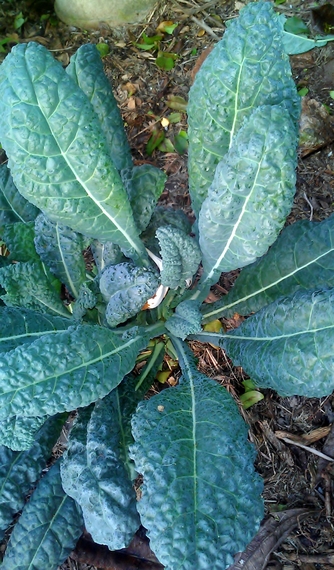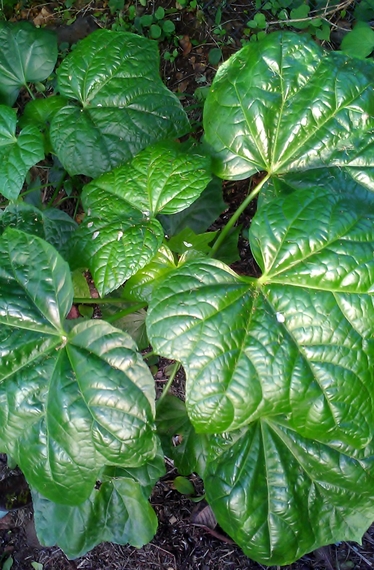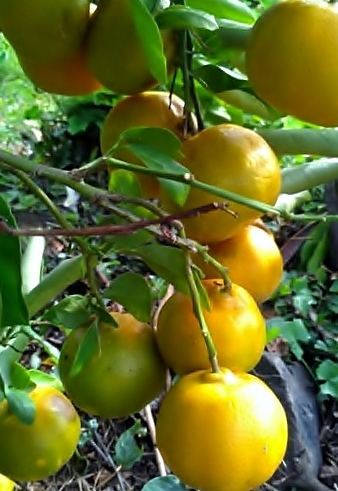The quick and dirty answer is: Eat the plants most closely related to the wild varieties that our hunter/gatherer ancestors consumed thousands of years ago.
This is the premise of Eating on the Wild Side, the missing link to optimum health by Jo Robinson. Ms. Robinson states that through the process of cultivation, countless generations of farmers have unwittingly eviscerated most of the essential nutrients that once nourished our forbears. The upshot is that the fruits and vegetables that make their way to the supermarket, and eventually on our tables, are virtually devoid of the protein, vitamins, minerals, fiber and antioxidants found in wild plants.
Obtaining these plants doesn't mean you'll have to forage for pig weed (a wild super food) or guava in the back of Manoa Valley. Instead she suggests when visiting the grocery store or the farmers market scan the isles for the closest relatives of the wild things.
You won't find wild tomatoes -- which have 30 times the cancer-fighting lycopene of cultivars -- at Safeway, but chances are pretty good you'll locate cherry tomatoes that pack 12 times the healthful phytonutrients of the larger but nutritionally vacuous beefsteak variety.
In her own iconoclastic way, Jo Robinson overwhelms us away with nutritional advice that is often counterintuitive and always compelling. All of her data is evidence-based, drawing from reviews of more than 600 scientific studies.
Here are some of her insights:
- Cooked carrots offer twice the beta carotene of raw carrots.
- The more blueberries you eat, the less likely you are to die of a heart attack.
- Bitter greens such as arugula, or lettuce that is red, red brown or purple are by far the most nutritious. (Stay away from wimpy iceberg lettuce.)
- Canned artichoke hearts are among the most nutritious foods in your refrigerator.
- Cooking some vegetables and fruits actually make them more nutritious. (For example, canned blueberries or canned tomatoes pack a ton more nutrients than the fresh variety.)
- Eating super sweet corn has the same impact on your blood sugar as scarfing a Hershey's chocolate bar.
- Scallions have 140 times more phytonutrients than a white onion.
- Beets have more antioxidant activity than most other vegetables except for artichokes, red cabbage, kale and bell peppers. Beets have nine times more than the typical tomato and fifty times more than orange carrots.
- Welch's Concord Grape juice is more nutritious than any other juice in the market (Costco has the Paul Newman's version which is probably just as good, if not politically correct).
A great deal of the fruits and veggies Ms. Robinson's proffers are available in Hawaii but naturally, the majority of these items are shipped in.
The good news is there is an overlap of super foods that both grow in Hawaii and on the mainland. The author also has an entire chapter devoted to tropical fruits, which comes in very handy for Hawaii residents. Here are some suggestions:
Kale: Ounce for ounce it's one of the best things you can consume, and it grows like gangbusters in Hawaii. According to Ms. Robinson, it's one of the few vegetables that meets or exceeds the nutritional value of some wild greens. For cancer-fighting and heart-protective qualities, it's tough to beat.
Edible hibiscus: Abelmoschus manihot, known as pele here in Hawaii, can be found throughout the South Pacific. I got to know it well in Fiji where it's called bele. A small shrub with soft, dark green leaves and a slightly viscous texture when cooked, it tops the charts with vitamin A and iron. It's fairly easy to transplant and you can get cuttings at some of the community organic gardens such as Ho'oulu Aina in the back of Kalihi Valley.
Drumstick tree or horse-radish tree: Moringa oleifera is a smallish shrub with yellowish-white flowers and long pods. It's easy to grow and the leaves have a delicate, pea-like flavor. Popular in Southeast Asia and in Hawaii among the Filipino population, it can be cooked hundreds of different delicious ways. It is a significant source of B vitamins, vitamin C, provitamin A as beta-carotene, vitamin K, manganese and protein, among other nutrients.
Okinawan sweet potatoes: Until recently, this made up almost 70 percent of the Okinawan diet. According to Dr. Brad Willcox, an expert on healthy aging at UH Medical School, the potatoes contain a powerful flavonoid and have a low-glycemic index, referring to the measure of how much a carbohydrate effects blood sugar levels. Anyone with a Costco card can get them very inexpensively.
Edamame: These have been mentioned in Chinese medical texts as early as 200 BC and contain all the essential amino acids, which make them a great substitute for animal protein. A half cup gives you five grams of fiber, ten grams of protein and significant amounts of vitamin K, folate and magnesium. Get 'em frozen at Costco.
Avocados Hardly exotic, these grow here in abundance. The modern varieties retain most of the nutrition of their Central American ancestors. One serving offers more antioxidants than a service of broccoli raab, grapes, red bell peppers or red cabbage. They are chock full of potassium, vitamin E, folate and magnesium. Just half a medium-sized avocado has six grams of soluble fiber.
Mangos: This fruit comes out of our ears in Hawaii and they are very, very good for you. They have five times more vitamin C than oranges and give more fiber than pineapples, not to mention a slew of phytonutrients.
Guava: Guava seems to grow wild everywhere on Oahu, and is an unsung nutritional hero. It's actually more nutritious than most other tropical fruits, including mangoes. A cup of sliced guava (red or white) has nine grams of fiber, a low glycemic load and four times the vitamin C of an orange.
Bananas: These are also ubiquitous around here. Avoid the store bought Cavendish variety, says Ms. Robinson, and go for the apple bananas or anything that's reddish or more golden in color. They are the ones with the carotenoids.
Papayas: Also grown in Hawaii -- Rainbow and Sunrise varieties get kudos from the author -- the redder the better. She singles out the Sunrise as the preferred item because it has twice the carotenoids of the more golden fleshed kinds.
Finally, there are pineapples: A fruit synonymous with the Aloha State. Both Maui Gold and Hawaii Gold varieties (developed by Del Monte) are sweeter and higher in beta-carotene than the traditional Cayenne version.
If you're interested in learning more about the best semi-wild things to eat, you couldn't have a better guide than Jo Robinson.
Rob Kay is a Honolulu-based healthy eater, freelance writer and author of Fijiguide.com, the world's leading travel guide to the Fiji Islands.


